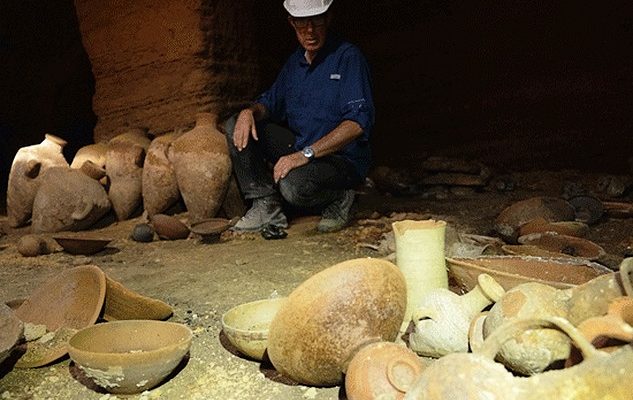“This is a once-in-a-lifetime find. It’s not every day that you see an Indiana Jones set – a cave with dishes on the floor that haven’t been touched in 3,300 years.”
By TPS
A burial cave from the time of Pharaoh Ramses II, containing dozens of intact objects and which has been untouched for some 3,300 years, was recently unexpectedly discovered in the Palmachim National Park on Israel’s coast.
The cave, which was accidentally discovered by a tractor that hit a rock during development work, revealing the ceiling of an ancient burial cave, was entered for the first time since it was closed about 3,300 years ago, during the reign of King Ramses II, also known as Ramses the Great, the pharaoh who some identify with the story of the Exodus.
Archaeologists from the Israel Antiquities Authority (IAA) were called to the site and descended the ladder into an amazing space that seemed frozen in time. Dozens of whole pottery and bronze vessels were laid out, just as they were placed during the burial ceremony. The vessels were offerings buried with the dead in the belief that they would be used by them in the next world.
The cave was carved in the shape of a square, and in the centre of its ceiling was a pillar.
Dr Eli Yanai, an expert on the Bronze Age at the IAA, stated that “this is a once-in-a-lifetime find. It’s not every day that you see an Indiana Jones set – a cave with dishes on the floor that haven’t been touched in 3,300 years.”
“We are talking about the Late Bronze Age. These are precisely the days of the famous king, Ramses II. The fact that the cave was sealed, and was not looted in later periods, allows us, with the scientific means available today, to extract a great deal of information from the objects and materials that survived on them and which are not visible to the eye, including organic materials,” he noted.
“The cave can provide us with a complete picture of burial customs in the Late Bronze Age. In the cave, mainly dozens of pottery vessels of various sizes and shapes were left. Among them, there are deep and shallow bowls, some of which are painted red, set cooking pots, jugs, and clay candles that contained oil for light,” he added.
Next to the jars, small storage vessels were found – mainly pitchers which were intended to store and trade precious materials in small quantities. These vessels were imported from the area of Tyre, Sidon, and other port cities on the coast of Lebanon. Also, many pottery vessels imported from Cyprus were found.
According to Dr Yanai, these types of vessels were imported to Israel in large quantities and were common by-products for burial.
Next to the pottery, bronze arrowheads or spearheads were found. Based on their position, they were placed in a garbage pile of organic material that did not survive.
“The findings in the cave date to the 13th century BCE,” said. Yanai. “During this period – in the days of the 19th Egyptian dynasty, the days of Ramses II, there was an Egyptian administration in the land, which allowed safe conditions for large-scale trade. These economic and social processes are well reflected in the finds of the cave: the pottery brought from Ugarit in the north, from Cyprus and the nearby coastal cities – mainly Jaffa, Ashdod, Ashkelon, Gaza, and Tel Ajul, testify that the residents of Yavne-Yam were integrated into the lively trade that was conducted throughout the shores of the country”.
In the short period of time before the opening was resealed, and despite security measures, one or more people entered the cave and probed at several points. The vast majority of the tools remained in place, but a number of items appeared to have been stolen. The circumstances of the case are being investigated.
Rumours about the discovery of the cave spread through the scientific world like wildfire, and Israel has many requests from researchers to join the expected archaeological dig.





